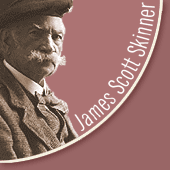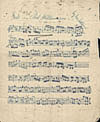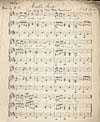




Please click any thumbnail image to view the full details.
There are 900 entries.
2 > 3 > 4 > 5 > 6 > 7 > 8 > 9 > 10 > 11 | next 10 of 90 pages
| Image | Title | Item Description |
|---|---|---|
 JSS0061 |
Lord Bob Williamson | Melody only of the 'Reel - Lord (inserted above title) "Bob Williamson" - 'by Jas. Scott Skinner'. The blue colour, and faint pink/purple paper, show that it was probably printed on an old type of duplicating machine with a rotating stencil, invented around 1890. There are seven single staves, which Skinner drew with stylus and ruler onto the stencil. The music is in B flat major, in 2/4 time. The melody has a repeated 4-bar section, and an eight-bar section with 1st and 2nd time bars, followed by a 16-bar variation not published in the Harp and Claymore. The printed version has a few minor changes to the melody in the first bar. |
 JSS0062 |
Cradle Song | The'Cradle Song' arranged and written out by Gavin Greig. The words are by Alexander Hastings, from Huntly, Aberdeenshire. Squeezed underneath the title is 'As sung by Miss Dolly Donaldson'. The music is in D major, and common time (C), in the usual arrangement of violin/voice part, and the piano part for two hands. The Harp and Claymore version added two bars: the first bar bass repeated as a one-bar introduction, and, to finish, a 'Last time' bar with a single bass D. 'D. C.' (Da Capo) returned the singer to the beginning for the remaining verses. Only the first verse is set here. Compare this with JSS0064, JSS0577. Listen to Skinner's recording by clicking on the audio link below. |
 JSS0063 |
Cradle Song, words | Skinner's Cradle Song, printed verses. (Below verse one is printed 'Ch. M. 18', which probably shows this version was published by Charles Middleton, Keith, perhaps in the Keith Sentinel - see JSS0053 and JSS0054.) |
 JSS0064 |
Cradle Song | Skinner's Cradle Song, as printed in The Logie Collection of Original Music for Voice, Violin and Pianoforte (Charles Middleton, Keith: 1888). Here, the melody is set for violin, not voice. Compare this version with JSS0062, where the Cradle Song vocal line is set comfortably for the middle range of most voices, and with JSS0577. Here, the violin begins five notes higher, since violinists, unlike singers, don't have to worry about how high they can play. Where music is played with one long bow stroke, Skinner uses slurs: curved lines over the notes. The vocal set is much simpler, and slurs are only used four times to show notes sung in one breath, on the words angel, darling, ever, and river. The song melody is also quite plain, and none of the small 'grace' notes which decorate the melody here are included. Listen to Skinner's recording by clicking on the link below. |
 JSS0065 |
Fingal's Dirk | Skinner's title is: Quickstep - 'Fingal's Dirk'* 'J. Scott Skinner'. A bagpipe setting in common time, and A major, with a natural sign replacing the the note G sharp, which Highland bagpipes lack. The music is set in four two stave systems, with the melody in the top stave. The accompaniment is usually in alternating octave quavers. Skinner remains within the 9-note range of the bagpipes throughout, but since the normal Highland bagpipes' pitch is closer to B flat, a fiddle and pipes duet in A would not be a success. Unusually, 'Fingal's Dirk' has a variation after each part of the tune. Skinner's note, below, explains that 'The order of playing the parts has always been 1st to give the whole melody and then the Var[iation]: the parts are here given in reverse order as composed. to Angus Macrae Callander, is it dedicated.' 'note [sic] Had I been a forger of arms Fingal said: - "Well would I form Knives; I would temper their blades with steel and their points with the hardest steel; their shafts of heather with their yellow heads, I would fix in the thick backs of the/ thin edges." This true poetical description of Dirks is thought to be the first invention of that weapon. See Poems of "Ossian" Hugh & John McCallum Montrose 1816 -'. |
 JSS0066 |
Hector Macdonald | 'March. "Hector Macdonald' (on pasted paper) 'J. Scott Skinner'. Sir Hector (1853-1903) was born near Dingwall, Ross-shire. He served at the Battle of Khartoum, was knighted in 1901, and became a Major-General in the British army. The key signature, A major with G natural, shows a bagpipe setting; the pipes have no G sharp. Metre, common time (C). The music is set in four two-stave systems, with the melody in 2 4-bar repeated sections. Then follows one unaccompanied variation (not indicated as such). Skinner has added musical phrasing wherever there are lighter pen or pencil marks. In the first line of music, for instance, he changes the rhythm of the second beat, adds grace notes (small extra notes, crossed stems up), and adds slurs (curved lines for phrasing, which also instruct the violinist to play the notes together, in one bow stroke). Below the music Skinner directs fiddlers to: Try to come as near the G [sharp] as possible. a [sic] good piper would play the above almost as perfect as the Violin by some mysterious process of fingering. |
 JSS0067 |
The Queen's Welcome to Invercauld | "The Queen's Welcome to Invercauld"', as printed in Skinner's Elgin Collection (1884). The music has been cut out, and pasted in, and Skinner has added 'Pipe March', and 'met[ronome marking]: 112' to the printed title. Invercauld, Aberdeenshire, is the site of Braemar Castle, seat of the Farquharsons of Invercauld. The unaccompanied melody was also published in Skinner's Scottish Violinist (1900). Skinner has added a manuscript 'Var[iatio]n' totalling 16 bars including repeats. Beneath, he has written: 'The Bagpipe cannot produce G [sharp], the chanter being fixed.' In the Harp and Claymore version, Skinner dealt with this problem by changing the last sharp, G, in the key signature to G natural, as he does in a number of other 'Pipe Marches'. The accompaniment there also differs, being in octaves rather than the chordal notes as shown here. You can listen to Skinner playing this by clicking on the audio link below (cd110a). |
 JSS0068 |
The Champion March | 'The Champion March' in two different printed, glued-in versions, in A major, signed at right 'J. Scott Skinner'. The first 16-bar melody is set with a single bass clef accompaniment. Skinner has added 'met[ronome marking]: 112' to the left. The second, 'Var[iation]. version has had the accompaniment cut off. Under the music he wrote 'For Pipe Settings of these Marches see D[avid]. Glen's Coll[ection]: [of Pipe Music] 8 Greenside Lane, Edinburgh [dedicated to] To The Late William Maclennan Champion Piper & Dancer who died in Montreal[.] The composer was a member of his company'. In the Harp and Claymore Skinner changed the last sharp (G) in the key signature to G natural, as he does in a number of other 'Pipe Marches' due to G sharp not being in the pipe scale. The accompaniment also differs, being in octaves rather than the chordal notes as shown here. |
 JSS0069 |
The Athole Highlanders Farewell to Loch Katrine | Quickstep. "The Athole Highlanders Farewell to Loch Katrine" by W(illia)m Rose', in Skinner's hand. The music has a natural sign where the G sharp would be, since the bagpipe scale lacks that note. The simple accompaniment suggests bagpipe drones. There is one 16-bar 'violin' variation. Skinner's footnote reads: The King of Pipe Marches. Click on the audio link to hear Skinner playing it. |
 JSS0070 |
Ballindalloch Castle | Skinner probably wrote Ballindalloch Castle for Lady MacPherson-Grant, whose name appears in Skinner's 'List of Patrons and Families who have Received Tuition from Mr and Mrs Scott Skinner' in his Miller o' Hirn Collection (1881). Ballindalloch Castle, Banff-shire, has been their family home since 1546. Upper left, above the staff, Skinner wrote '3 Quickstep -' in blue crayon. His untypically small signature is to the right. The 2-part, four-bar, repeated melody has two variations, one with arpeggios and scale passages, the second added triplets. Skinner's typical bass line uses octaves, separately, together, or an octave apart, with a few harmonic notes added, and open fifths with grace notes in the fifth system, to suggest bagpipe drones. Skinner writes, below: all the above may be played on the pipes in the diatonic scale of A excepting the G's / which are natural - they should be played as written on Violin & Piano'. A neat music example for pipes and fiddle follows; 'pipes play the upper notes', he adds. Click on the audio link below. |
2 > 3 > 4 > 5 > 6 > 7 > 8 > 9 > 10 > 11 | next 10 of 90 pages


Historic Collections · Kings
College · Old Aberdeen · AB24 3SW
Tel:(0)44 1224 274312 · E-mail: scottskinner@abdn.ac.uk
Page design by IT Services Web Team